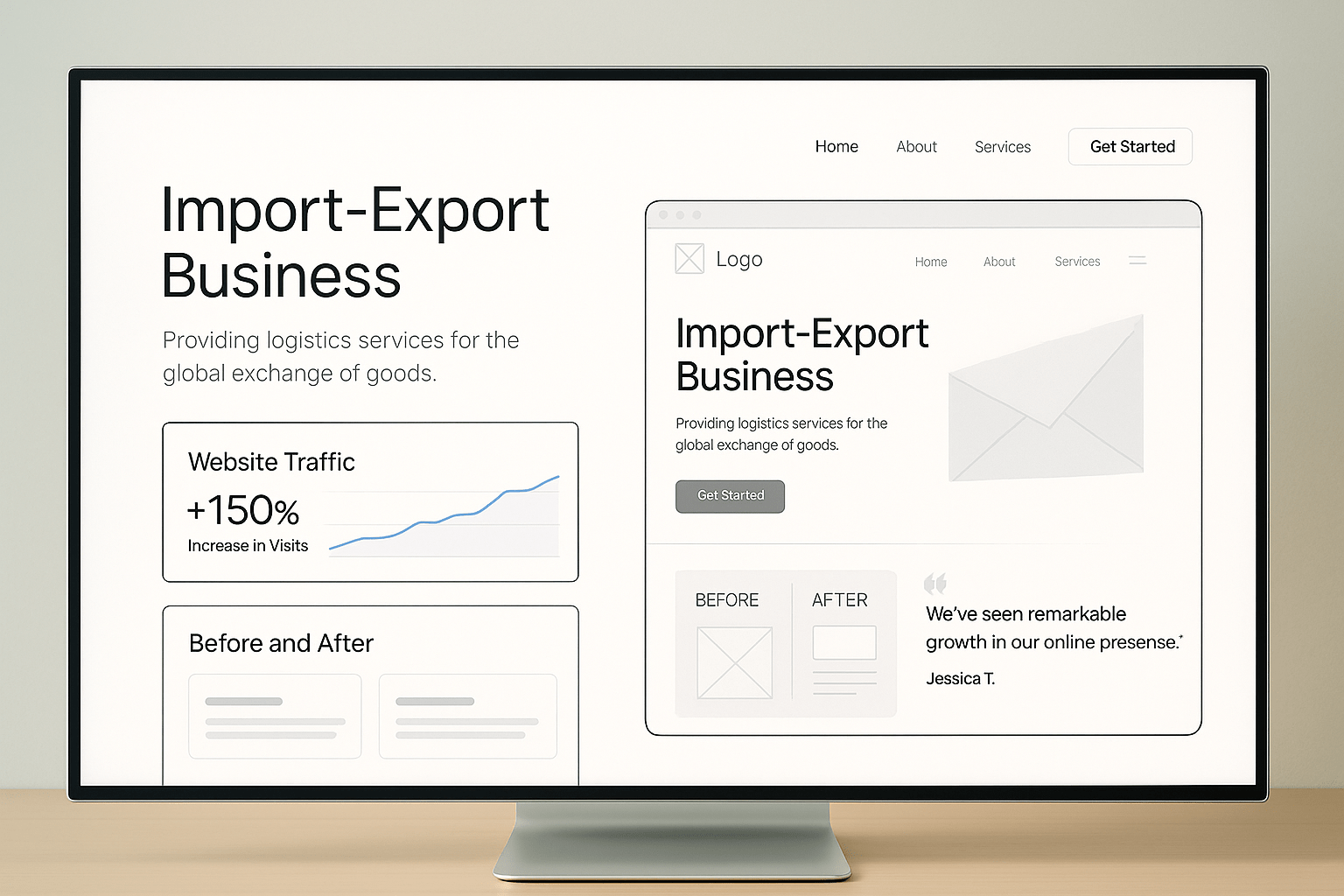Web Development for Import-Export Companies — Streamline Operations
by Design Delulu Editorial · September 14, 2025

In today's interconnected global economy, import-export companies face unprecedented challenges in managing complex international transactions, regulatory compliance, and multi-stakeholder communications. The traditional methods of handling paperwork, tracking shipments, and coordinating with suppliers and buyers across different time zones are no longer sufficient to remain competitive in this rapidly evolving marketplace.
Modern import-export businesses require sophisticated digital solutions that can streamline operations, enhance client experiences, and provide real-time visibility into their supply chain processes. This is where strategic web development becomes not just an advantage, but a necessity for survival and growth in the international trade sector.

Why Import-Export Companies Need Web Development
Key Challenges Import-Export Companies Face
Import-export businesses operate in one of the most complex commercial environments, dealing with multiple pain points that can significantly impact their efficiency and profitability:
- Documentation and Compliance Management: Managing hundreds of documents including bills of lading, customs declarations, certificates of origin, and insurance papers across multiple jurisdictions creates administrative bottlenecks and increases the risk of costly errors.
- Supply Chain Visibility: Traditional communication methods make it difficult to track shipments in real-time, leading to customer dissatisfaction and missed delivery commitments. Without proper visibility, companies struggle to proactively address delays or issues.
- Multi-Currency and Multi-Language Operations: Dealing with international clients requires seamless currency conversions, multi-language support, and localized payment processing capabilities that manual systems cannot efficiently handle.
- Regulatory Compliance: Ever-changing international trade regulations, tariff structures, and customs requirements demand constant updates and accurate record-keeping that paper-based systems cannot adequately support.
How Web Development Solves These Challenges
Strategic web development addresses these pain points through integrated digital solutions:
- Automated Documentation Systems: Custom web applications can automatically generate, store, and organize trade documents, ensuring compliance while reducing manual errors and processing time by up to 70%.
- Real-Time Tracking and Communication: Web-based portals provide clients and stakeholders with instant access to shipment status, documentation, and delivery updates, improving transparency and customer satisfaction.
- Integrated Financial Management: Web platforms can seamlessly handle multi-currency transactions, automatic exchange rate calculations, and diverse payment methods, streamlining the financial aspects of international trade.
- Compliance Automation: Smart web systems can automatically update regulatory requirements, flag potential compliance issues, and maintain audit trails for regulatory inspections.

Essential Features of Web Development for Import-Export Companies
Must-Have Tools and Functionalities
- Customer Portal Integration: A comprehensive client dashboard that allows customers to track orders, access documents, communicate with account managers, and initiate new transactions without requiring direct staff intervention.
- Inventory Management Systems: Real-time inventory tracking that syncs with warehouse management systems, providing accurate stock levels and automated reorder alerts to prevent stockouts or overstock situations.
- Supplier Network Management: Centralized supplier databases with performance metrics, quality ratings, and communication histories that enable better vendor selection and relationship management.
- Mobile-Responsive Design: Since import-export operations often involve field work and travel, mobile-optimized interfaces ensure that critical information and functions are accessible from any device, anywhere in the world.
Real-World Implementation Examples
- Automated Quote Generation: Web systems can instantly calculate shipping costs, customs duties, and total landed costs based on product specifications, destination countries, and current market rates, providing customers with immediate pricing information.
- Digital Document Workflow: Integration with customs authorities and shipping lines through APIs allows for electronic document submission and status tracking, reducing processing times from days to hours.
- Multi-Modal Shipping Optimization: Advanced web applications can compare different shipping routes and methods (air, sea, land) in real-time, automatically selecting the most cost-effective or time-efficient options based on customer preferences.

Common Mistakes to Avoid
Typical Pitfalls in Web Development for Import-Export Companies
- Over-Complicating User Interfaces: Many companies create overly complex systems that overwhelm users. Import-export operations involve multiple stakeholders with varying technical expertise, so interfaces must be intuitive and user-friendly.
- Inadequate Security Measures: Given the sensitive nature of trade data and financial information, insufficient security protocols can expose companies to cyber threats and regulatory violations. This includes weak authentication systems and unencrypted data transmission.
- Lack of Scalability Planning: Failing to design systems that can handle growth in transaction volume, geographic expansion, or additional product lines often results in costly system overhauls as the business expands.
- Poor Integration Capabilities: Creating isolated systems that don't communicate with existing ERP, accounting, or logistics software leads to data silos and inefficient workflows.
How to Do Better
- User-Centered Design Approach: Conduct thorough user research to understand the specific needs of different stakeholders (customers, suppliers, internal teams) and design interfaces that cater to their unique requirements and technical comfort levels.
- Implement Robust Security Framework: Deploy enterprise-grade security measures including multi-factor authentication, end-to-end encryption, regular security audits, and compliance with international data protection regulations like GDPR.
- Design for Future Growth: Build modular, cloud-based systems that can easily accommodate increased transaction volumes, new markets, additional product categories, and evolving business requirements without major architectural changes.
- Prioritize Integration: Ensure seamless connectivity with existing business systems, industry-standard EDI protocols, and major shipping and logistics platforms to create a unified operational ecosystem.
SEO and Growth Best Practices
Optimization Tips Specific to Import-Export Companies
Local SEO for Global Reach: While import-export companies operate internationally, they often serve specific regional markets. Optimize for location-based keywords like "import services in [city]" or "export solutions [country]" to capture local business seeking international trade services.
Industry-Specific Content Strategy: Create valuable content around trade regulations, market insights, and logistics optimization. This positions your company as a thought leader while attracting organic traffic from businesses seeking expertise in international trade.
Technical SEO for Complex Websites: Import-export websites often have complex structures with multiple product categories and regional variations. Implement proper URL structures, schema markup for products and services, and international SEO best practices (hreflang tags) to ensure search engines can properly index and rank your content.
Conversion Optimization: Focus on clear calls-to-action for quote requests, consultation bookings, and resource downloads. Import-export services often involve high-value, complex transactions, so your website must effectively guide prospects through the decision-making process.
Leveraging Web Development for Visibility and Results
Performance Optimization: Fast-loading websites are crucial for import-export companies as clients often need to access information quickly during business hours across different time zones. Optimize images, implement caching, and use content delivery networks (CDNs) to ensure global accessibility.
Analytics and Insights: Implement comprehensive tracking to understand user behavior, popular services, and conversion patterns. This data helps refine marketing strategies and identify new business opportunities in different markets or product categories.
Social Proof Integration: Display client testimonials, case studies, and industry certifications prominently to build trust with potential customers who are considering entrusting their valuable shipments to your services.
Lead Nurturing Systems: Develop automated email sequences and targeted content that educate prospects about import-export processes, helping them understand the value of professional services while moving them through the sales funnel.
Measuring Success and ROI
The impact of effective web development for import-export companies extends far beyond simple website metrics. Success should be measured through operational efficiency improvements, customer satisfaction scores, and revenue growth indicators.
Key performance indicators include reduction in documentation processing time, increased customer retention rates, expansion into new markets facilitated by digital capabilities, and overall cost savings from automated processes. Companies typically see a 200-300% return on investment within the first two years of implementing comprehensive web development solutions.
The competitive advantage gained through superior digital infrastructure often translates into the ability to offer more competitive pricing, faster service delivery, and enhanced reliability – factors that are crucial for success in the import-export industry.
Ready to transform your import-export operations with cutting-edge web development?
👉 Explore Design Delulu's Web Development Services and discover how we can streamline your international trade operations.